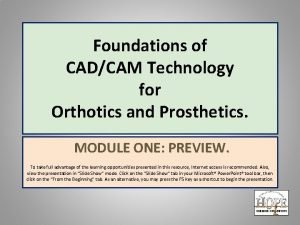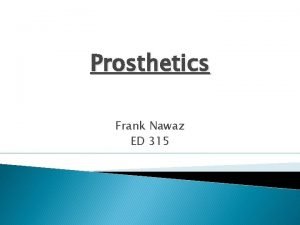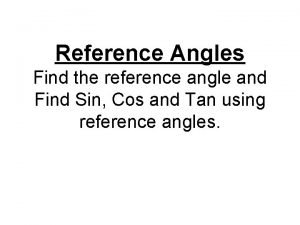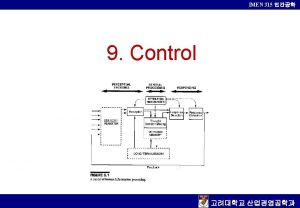Prosthetics Frank Nawaz ED 315 What is it



















- Slides: 19

Prosthetics Frank Nawaz ED 315

What is it? � An artificial device used to replace a missing body part, such as a limb.


Background information � Ancient times, the most notable one being the simple peg leg. � In the Middle Ages the first sophisticated prostheses were made, using strong and heavy iron to make limbs. � Even with the articulated joints invented by Ambroise Paré in the 1500 s, the amputee could not flex at will. Artificial hands of the time were intricate imitations of real hands, but were not exceptionally functional. � Peter Baliff of Berlin in 1812 for below-elbow amputees � Van Peetersen in 1844 for above-elbow amputees, were functional, but still not fully flexible.


Background information � The nineteenth century, J. E. Hanger, an engineering student, lost his leg in the Civil War. He designed an artificial leg for himself and in 1861 founded a company to produce prosthetic legs. � Another amputee named A. A. Winkley developed a slip-socket below-knee device for himself, and founded the Winkley Company in 1888. � Another amputee named D. W. Dorrance invented a terminal device to be used in the place of a hand in 1909. His terminal device (the hook) is still considered to be a major advancement for amputees because it restored their ability to grab to some extent. Modified hooks are still used today.


Usefulness/Purpose � Provides fluid movement and allows to have the use of arms or legs.

How does it work? � Functional prosthetic limbs can actually be controlled in a variety of ways. � a prosthetic arm can be controlled through a cable attached with a strap or harness to the opposite, healthy shoulder. The working shoulder is then moved in certain ways to control the prosthetic device -- similar to how you might use a hand lever on your bike to control the brakes.



How does it work? � Equipped with a variety of mechanisms that help them to move naturally as a patient walks or runs. � A prosthetic knee is particularly difficult to engineer, as it must constantly adjust to allow for normal walking, standing and sitting. � Advanced artificial legs have a computercontrolled knee that automatically adapts to adjust to the patient's walking style.



Advantages & Disadvantages � Advantage movement. - Provides freedom and fluid � Disadvantage – Discomfort, price

Cost �A lower extremity prosthesis (leg) can range in cost from $5, 000. 00 to $50, 000. � An upper extremity device (arm) can range from $3, 000. 00 to $30, 000.

Reliabiltiy � Very reliable � Made with the best materials � Flexible movement

Availability in the CNMI � Shriners � Every Children’s Hospital 6 months � Newborn-18 years old

Sources � http: //www. answers. com/topic/artificial-limb � http: //www. disabledworld. com/assistivedevices/p rostheses/prosthetics-costs. php � http: //science. howstuffworks. com/prosthetic- limb 4. htm � http: //catalogs. indiamart. com/products/artificial- limbs. html
 Cad cam prosthetics
Cad cam prosthetics Orthotics birmingham
Orthotics birmingham Muhammad nawaz sharif university of agriculture multan
Muhammad nawaz sharif university of agriculture multan Usman nawaz missing
Usman nawaz missing Shah nawaz burokur
Shah nawaz burokur Frank william abagnale jr
Frank william abagnale jr Ba 315
Ba 315 Reference angle
Reference angle Syster 315
Syster 315 Exact value of sin 240
Exact value of sin 240 Suatu kotak perhiasan berbentuk balok dengan panjang 20 cm
Suatu kotak perhiasan berbentuk balok dengan panjang 20 cm (270° < x < 360°) terletak pada kuadran
(270° < x < 360°) terletak pada kuadran Isa 315 revised
Isa 315 revised Ee 315
Ee 315 Kombinasi lanjar pbb
Kombinasi lanjar pbb 315 production
315 production 315
315 Isa 315 changes
Isa 315 changes Economic 315
Economic 315 Nep 330
Nep 330





































